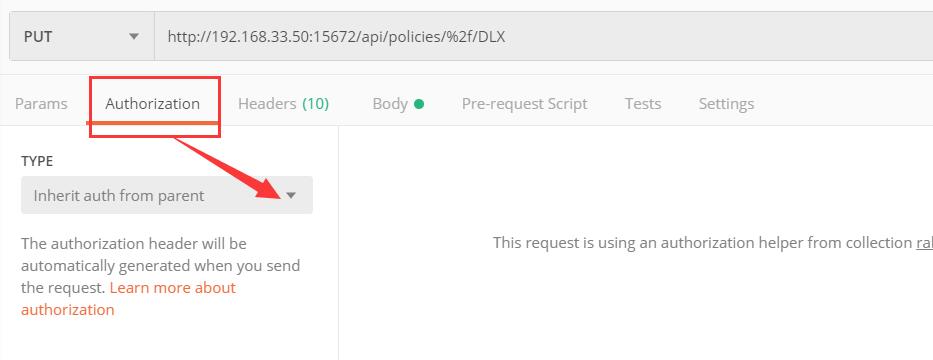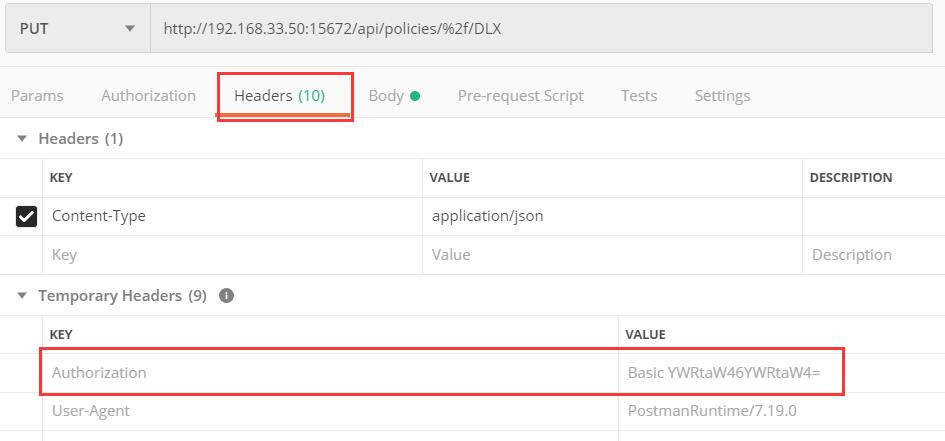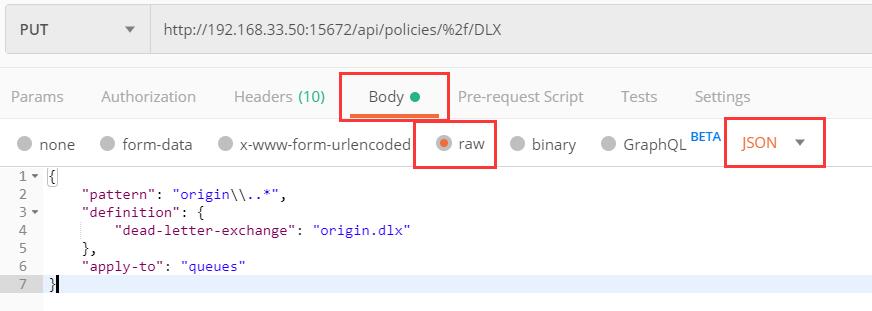需求:
exchange 和 queue 都能重复声明不会影响已有数据,但是 DLX 只能在 queue 第一次创建的时候一起定义,否则运行时就需要通过 WEB UI 或者 rabbitmqctl set_policy 命令行指令来添加 DLX。如果对已经存在的 queue 使用 java API 的方式添加 DLX 绑定则会报错。而我在写demo时定义了默认的 exchange 和 queue,所以希望默认的 dlx 也能通过 java API 方式重复声明。
解决方案:
去官网找了一些 HTTP API 资料,但官网只给出 SET_POLICY 方式,相应的 HTTP API 没有给出具体示例。于是根据已有资料中一些其他的 HTTP API 的规则、WEB UI 中 Policies 接口的存在,还有 SET_POLISY DLX 的规律,猜测 DLX policy HTTP API 的调用方式,最后比较简单地试出了 DLX HTTP API 的调用方式。
代码会跟随 RabbitMQ 的某个小demo不久后会正式分享到 github,现在就直接贴代码吧。
Policies HTTP 设置 DLX 代码:
PS:DELETE 方法中 pattern 为 ""(空字符串)就可以了。这里没有完全优化。
1 private static final String DEFAULT_DLX_URL = "http://192.168.33.50:15672/api/policies/%2f/DLX" 2 3 public static void declareDlxForDefaultQueueViaHttpClient(boolean bind) { 4 HttpEntityEnclosingRequestBase request; 5 if (bind) { 6 request = new HttpPut(DEFAULT_DLX_URL); 7 } else { 8 request = new HttpDeleteWithEntity(DEFAULT_DLX_URL); 9 } 10 CredentialsProvider credentialsProvider = new BasicCredentialsProvider(); 11 Credentials credentials = new UsernamePasswordCredentials(DEFAULT_USERNAME, DEFAULT_USER_PWD); 12 // 这里可以用 AuthScope.ANY 替代。表示任何 URL domain 都使用同一个 AUTH 13 credentialsProvider.setCredentials(new AuthScope(DEFAULT_HOST, DEFAULT_MANAGEMENT_PORT), credentials); 14 // BasicAuth 验证由 HttpClient API 来处理 15 CloseableHttpClient httpClient = HttpClientBuilder.create().setDefaultCredentialsProvider(credentialsProvider).build(); 16 JSONObject dlxJson = new JSONObject(); 17 dlxJson.put("pattern", "origin\..*"); 18 JSONObject definition = new JSONObject(); 19 definition.put("dead-letter-exchange", "origin.dlx"); 20 dlxJson.put("definition", definition); 21 dlxJson.put("apply-to", "queues"); 22 StringEntity entity = new StringEntity(dlxJson.toString(), ContentType.APPLICATION_JSON); 23 // 有些方法不能带请求体,所以请求体不能放到 HttpClient API 里 24 request.setEntity(entity); 25 try { 26 CloseableHttpResponse httpResponse = httpClient.execute(request); 27 int statusCode = httpResponse.getStatusLine().getStatusCode(); 28 HttpEntity responseEntity = httpResponse.getEntity(); 29 String responseBody = responseEntity == null ? "empty response body" : EntityUtils.toString(responseEntity); 30 log.info("IN declare DLX for DEFAULT QUEUE:request method=" + request.getMethod() 31 + ", statusCode=" + statusCode + ", responseBody=" + responseBody); 32 } catch (IOException e) { 33 e.printStackTrace(); 34 } 35 }
模拟 HttpPut 构造 HttpDeleteWithEntity 代码:
1 public class HttpDeleteWithEntity extends HttpEntityEnclosingRequestBase { 2 3 public final static String METHOD_NAME = "DELETE"; 4 5 public HttpDeleteWithEntity() { 6 super(); 7 } 8 9 public HttpDeleteWithEntity(final URI uri) { 10 super(); 11 setURI(uri); 12 } 13 14 /** 15 * @throws IllegalArgumentException if the uri is invalid. 16 */ 17 public HttpDeleteWithEntity(final String uri) { 18 super(); 19 setURI(URI.create(uri)); 20 } 21 22 @Override 23 public String getMethod() { 24 return METHOD_NAME; 25 } 26 }
pom.xml 代码:

1 <dependencies> 2 <!-- https://mvnrepository.com/artifact/org.apache.httpcomponents/httpclient --> 3 <dependency> 4 <groupId>org.apache.httpcomponents</groupId> 5 <artifactId>httpclient</artifactId> 6 <version>4.5.10</version> 7 </dependency> 8 9 <dependency> 10 <groupId>com.alibaba</groupId> 11 <artifactId>fastjson</artifactId> 12 <version>1.2.62</version> 13 </dependency> 14 15 <dependency> 16 <groupId>junit</groupId> 17 <artifactId>junit</artifactId> 18 <version>4.12</version> 19 <scope>test</scope> 20 </dependency> 21 22 <dependency> 23 <groupId>com.rabbitmq</groupId> 24 <artifactId>amqp-client</artifactId> 25 <version>5.4.3</version> 26 <scope>compile</scope> 27 </dependency> 28 29 <dependency> 30 <groupId>org.projectlombok</groupId> 31 <artifactId>lombok</artifactId> 32 <version>1.18.10</version> 33 <scope>provided</scope> 34 </dependency> 35 36 <!--logback 日志框架,只需要引入这个--> 37 <dependency> 38 <groupId>ch.qos.logback</groupId> 39 <artifactId>logback-classic</artifactId> 40 <version>1.2.3</version> 41 </dependency> 42 </dependencies>
需要注意:
当 DLX 关系存在或不存在时,API 的返回稍微有点不同,某些情况需要额外判断,如上面代码中对 responseEntity 的判断。
用 POSTMAN 来模拟 policies set dlx:
图1:因为我单独建了一个 collection,默认当前 collection 下所有请求都使用 Basic Auth 并自动把 username 和 password 都填了。所以没有设置这个默认选项的同学手动选一下,图中位置下拉框选中 Basic Auth,填上 RabbitMQ management 管理账号就可以了
PS:注意 HTTP 方法要选择 PUT。

图2:header 设置,这是发完请求后才截图的,可以看到 temporary headers 里面有 Authorization ~

图3:body 设置

嗯,在 POSTMAN 里面发个请求比在 java 程序里跑个 test 方法快多了。
参考资料:
https://lists.rabbitmq.com/pipermail/rabbitmq-discuss/2013-May/027573.html
RabbitMQ 官网 DLX 和 HTTP API 相关参考:
https://www.rabbitmq.com/parameters.html
https://www.rabbitmq.com/dlx.html
HttpClient:https://hc.apache.org/httpcomponents-client-ga/tutorial/html/authentication.html#d4e1023
HttpDelete 缺失 Set Entity 方法相关解决办法参考:https://stackoverflow.com/questions/43241436/java-http-delete-with-request-body
Basic Auth 作为一种 http header 的基本原理:https://www.baeldung.com/how-to-use-resttemplate-with-basic-authentication-in-spring#maven
